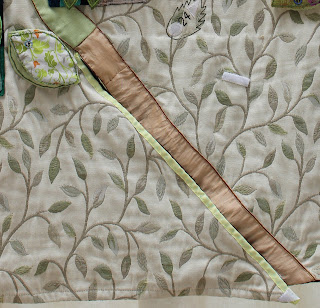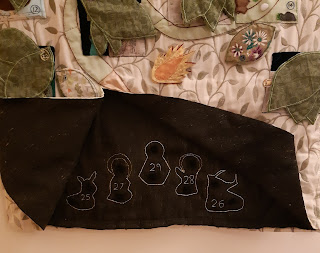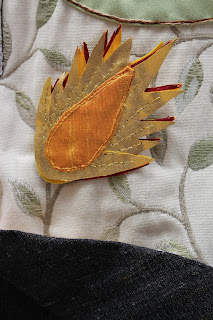When Lent and Easter fall varies within parameters related to the moon but Lent is always the same length of time.
Christmas is always 25 December, but Advent varies in length and start date related to the day of the week on which Christmas falls. Advent is 4 Sundays before Christmas. Some of you may be old enough to remember Blue Peter making an advent wreath with 4 candles.
What does this mean? If Christmas falls on a Sunday, that's a full extra week of Advent, and the first day of Advent could be in November. But if Christmas falls on a Monday, Advent is cut short - it's only 23 days.
So how do you manage that on an advent calendar without continually making a new one? I decided to build in some flexibility which would allow people to both follow the religious way of doing things, or to stick with the commercial generally followed way of doing things. I made each element of the final nativity scene something you could add on individually, or, if you choose you could add them on all together.
So "scene" 24 is the star in the east.
Except as you can see, it's not a star, it's a comet.
Some people have thought that the star seen by the wise men was Haley's Comet and I chose to show it like that, partly in honour of my brother who is an Astronomer and studied Comet like stars!
There's no covering leaf here because you add these elements on, much like Mary and Joseph on the donkey earlier.
So how do you know where it goes? Instead of a leaf, you've got an outline behind. and on the back of the star is the number to match up.
For the star on the light background the outline is in black.
The final "scenes" 25 to 29 are the individual parts of the nativity scene.
I wanted there to be a sense of a big reveal to this section, so I decided that there should be a much larger "door" or "flaps" that should open out to reveal the area for the nativity. Having used the road structure through the advent calendar, it made a really useful place to make the flap for the hidden place. Once I'd planned for the flaps I decided to make the hidden area dark grey - to give the feel of a dark cave or stable.


The figures are added on in order of importance, ending with the most important!
25 and 26 are the donkey and the ox that are frequently added to nativity scenes.
27 and 28 are Joseph and Mary, and 29 is Jesus.
So if you want to play it safe and only have 25 days every year, you can add on the whole scene for Christmas day every year.
BUT you have started with Advent Sundays and it varies, on a short year 24-29 are added on all together, and if it's a long year, you can add on each element one by one. And in between you can just add the last few on together varyingly.
The last feature is somewhere to hold all the loose parts - there are pockets on the back to hold the leaves and the different bits that come away. Sadly I don't have a picture.
And with that, my posts are all complete! Good news though - I've another project to catch you up on...it's a lot more nerdy.



No comments:
Post a Comment